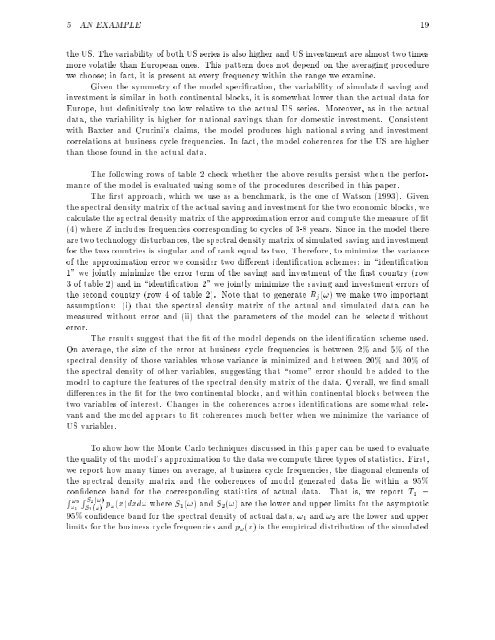Testing Calibrated General Equilibrium Models - Universitat ...
Testing Calibrated General Equilibrium Models - Universitat ...
Testing Calibrated General Equilibrium Models - Universitat ...
Create successful ePaper yourself
Turn your PDF publications into a flip-book with our unique Google optimized e-Paper software.
5 AN EXAMPLE 19<br />
the US. The variability of both US series is also higher and US investment are almost two times<br />
more volatile than European ones. This pattern does not depend on the averaging procedure<br />
we choose in fact, it is present atevery frequency within the range we examine.<br />
Given the symmetry of the model speci cation, the variability ofsimulated saving and<br />
investment is similar in both continental blocks, it is somewhat lower than the actual data for<br />
Europe, but de nitively too low relative to the actual US series. Moreover, as in the actual<br />
data, the variability is higher for national savings than for domestic investment. Consistent<br />
with Baxter and Crucini's claims, the model produces high national saving and investment<br />
correlations at business cycle frequencies. In fact, the model coherences for the US are higher<br />
than those found in the actual data.<br />
The following rows of table 2 check whether the above results persist when the performance<br />
of the model is evaluated using some of the procedures described in this paper.<br />
The rst approach, which we use as a benchmark, is the one of Watson (1993). Given<br />
the spectral density matrix of the actual saving and investment for the two economic blocks, we<br />
calculate the spectral density matrix of the approximation error and compute the measure of t<br />
(4) where Z includes frequencies corresponding to cycles of 3-8 years. Since in the model there<br />
are twotechnology disturbances, the spectral density matrix of simulated saving and investment<br />
for the two countries is singular and of rank equal to two. Therefore, to minimize the variance<br />
of the approximation error we consider two di erent identi cation schemes: in \identi cation<br />
1" we jointly minimize the error term of the saving and investment of the rst country (row<br />
3 of table 2) and in \identi cation 2" we jointly minimize the saving and investment errors of<br />
the second country (row 4 of table 2). Note that to generate Rj(!) wemaketwo important<br />
assumptions: (i) that the spectral density matrix of the actual and simulated data can be<br />
measured without error and (ii) that the parameters of the model can be selected without<br />
error.<br />
The results suggest that the t of the model depends on the identi cation scheme used.<br />
On average, the size of the error at business cycle frequencies is between 2% and 5% of the<br />
spectral density of those variables whose variance is minimized and between 20% and 30% of<br />
the spectral density ofothervariables, suggesting that \some" error should be added to the<br />
model to capture the features of the spectral density matrix of the data. Overall, we nd small<br />
di erences in the t for the two continental blocks, and within continental blocks between the<br />
two variables of interest. Changes in the coherences across identi cations are somewhat relevant<br />
and the model appears to t coherences much better when we minimize the variance of<br />
US variables.<br />
To show how the Monte Carlo techniques discussed in this paper can be used to evaluate<br />
the quality of the model's approximation to the data we compute three types of statistics. First,<br />
we report how many times on average, at business cycle frequencies, the diagonal elements of<br />
the spectral density matrix and the coherences of model generated data lie within a 95%<br />
con dence band for the corresponding statistics of actual data. That is, we report T 1 =<br />
R !2<br />
!1<br />
R S2(!)<br />
S1(!) p!(x)dxd! where S 1(!) and S 2(!) are the lower and upper limits for the asymptotic<br />
95% con dence band for the spectral density ofactualdata,! 1 and ! 2 are the lower and upper<br />
limits for the business cycle frequencies and p!(x) is the empirical distribution of the simulated
















